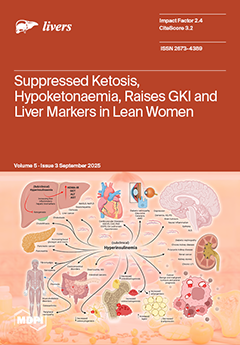Background: As the growing global population continues to age, the risk of chronic metabolic diseases, including cardiovascular disease, neurodegenerative disorders, type 2 diabetes mellitus, and fatty liver disease, increases considerably. Driven largely by lifestyle factors and metabolic dysfunction, this escalating health crisis is
[...] Read more.
Background: As the growing global population continues to age, the risk of chronic metabolic diseases, including cardiovascular disease, neurodegenerative disorders, type 2 diabetes mellitus, and fatty liver disease, increases considerably. Driven largely by lifestyle factors and metabolic dysfunction, this escalating health crisis is placing mounting pressure on healthcare systems and contributing to significant economic costs. Insulin resistance and hyperinsulinaemia are major drivers of these disorders, emphasising the need for early detection and intervention. Changes in liver enzymes, such as alanine aminotransferase (ALT) and gamma-glutamyl transferase (GGT), commonly assessed in routine laboratory testing, can serve as biomarkers of early-stage insulin resistance, offering a potentially underutilised window for intervention and disease prevention. Correspondingly, low-carbohydrate ketogenic diets have shown to be effective in reversing insulin resistance, metabolic disease, and liver disease. Objectives: We chose to explore the relationship between suppressing ketosis and changes in liver enzymes in the Ketosis Suppression and Ageing cohort. Methods: Ten lean (BMI 20.5 kg/m
2 ± 1.4), healthy young women (age 32.3 ± 8.9 years) who habitually followed a ketogenic diet maintaining nutritional ketosis (NK) for an average of 3.9 years (±2.3) were exposed to a higher carbohydrate diet, in line with standard healthy eating guidelines for a 21-day phase and then transitioned back to a ketogenic diet. Results: Carbohydrate challenge and suppression of ketosis increased insulin resistance score HOMA-IR by 2.13-fold (
p = 0.0008), GKI by 22.28-fold (
p = 0.0024), and liver markers ALT by 1.85-fold (
p = 0.0010), GGT, 1.29-fold (
p = 0.0087) and the ALT/AST, 1.30-fold (
p = 0.0266), reflecting an adverse pattern suggestive of hepatic insulin resistance. Conclusions: These results support the clinical utility of liver markers as early and directional signs of hyperinsulinaemia.
Full article





